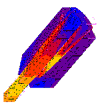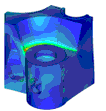|
FEA |
|
|
Here each part of a 2D or 3D model or machine system is remodeled as an arrangement of inter-related blocks or elements. The shapes and inter-relations of these elements are defined mathematically.
|

|
|
When external factors are applied to the virtual component or system e.g. force, displacement, temperature or vibration, the computer calculates the resultant changes in each of the elements plus the effect that those elemental changes have on all the other elements.
|

|
|
It also considers the material's properties and factors such as sliding friction.
In this way we can predict how a complex shaped component or assembly will behave under multiple loads, temperature changes, movements or any combination of them and other external factors.
|

|
|
The application of FEA is not just for new equipment designs. It can be used to identify design weaknesses in existing machinery.
|

|
|
Or solve process problems such as crease defects in metal forming and shrinkage cracks in cooling castings
Finite Element Analysis is a very powerful technique, which has been around for more than 20 years but has been dominated by the advanced technology industries and universities.
|

|
|
By cutting through the jargon and concentrating on offering practical results, rather than the impressive technology, we can demonstrate the cost effectiveness of this technique for solving everyday design problems, on every day components and machines - particularly related to stress and deflection.
Our primary Finite Element systems are: -
1. MSC Nastran 4D 2002 for Linear Analysis
2. MSC Marc 2003 with Patran and Mentat for Non-Linear Analysis
3. Roshaz. FEA for Refined Linear Analysis
|

|

